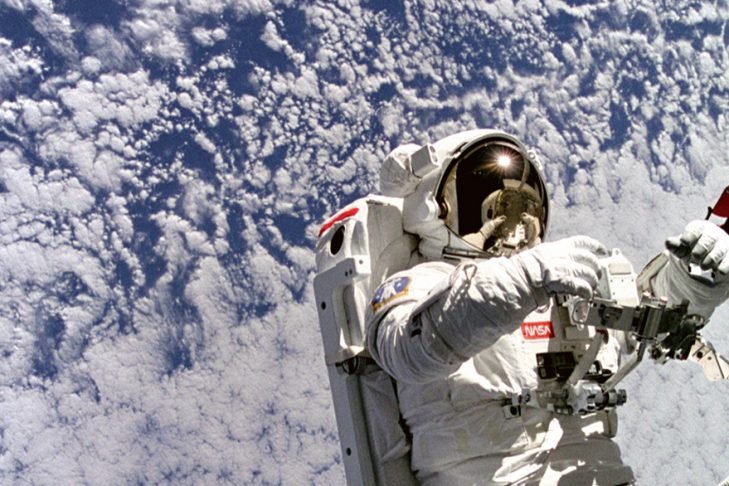On Dec. 12, 2017, I met an astronaut. I had been invited by Rachel Raz, director of the Early Childhood Institute at Hebrew College in Newton, to hear Dr. Jeff Hoffman, Jewish astronaut and five-time space shuttle veteran, speak at their eighth annual Early Childhood Jewish Education Conference.
Meeting an astronaut was a dream come true. As a little girl I dreamed of being an astronaut. At some point it occurred to me that to be an astronaut I would have to be good at math. My inability to do even simple addition in my head, a condition that persists to this day, didn’t stop me from being a fanatical follower of the space program, even when I knew for sure they wouldn’t be fitting me for a spacesuit anytime soon.
My obsession began with the 15-minute, suborbital flight of Alan Shepard in 1961, part of Project Mercury. It continued through the exploits of the two-man Project Gemini crews, who paved the way for the moon landing. I thrilled to the flights of Project Apollo, culminating with the first moon landing in July 1969, which I watched with a group of friends at a sleepover.
My space obsession continued into adulthood. I devoured Tom Wolfe’s The Right Stuff and saw the movie, read Andrew Chaikin’s A Man on the Moon: The Voyages of the Apollo Astronauts and Homer Hickam’s Rocket Boys: A Memoir. I held my breath during the Tom Hanks movie Apollo 13, watched Hidden Figures, the film about a group of black female mathematicians who were invaluable to NASA in the 1960s, and, of course, I’ve seen every incarnation of Star Trek, Star Wars and any other movies that involve space travel.
I visited the Smithsonian’s two Air and Space Museums over the years, and last spring finally made it to Cape Canaveral as a bug-eye tourist. A high point was the display of lunar samples, which includes a moon rock you can touch. Which I did! I thought I’d completed my mission as a space program fanatic. Then I met an astronaut.
At the lunch at Hebrew College, I was introduced to Hoffman, a real, live Jewish astronaut. Hoffman spoke to 200 conference attendees. He began by recalling his early interest in space exploration. He remembered his third-grade teacher, Mrs. MacArthur, who encouraged his interest in space. “I was probably doodling rockets,” said Hoffman. “But it shows you how a teacher can really affect a whole life. Everyone needs a Mrs. MacArthur. I really wish that she had lived long enough that I could thank her.” This is one of the many reasons Rachel Raz had invited him to speak. “I ask my students to think, where will their students be in 10 or 20 years?” says Raz. “I ask them, who inspired you? I encourage them to be like the teacher Jeff remembers.”
During his flights, Hoffman velcroed a mezuzah to his sleeping compartment. He also brought the attarah (the decoration on the top of a tallit) from the tallit used at his sons’ bar mitzvahs and as part of their wedding chuppahs. His first flight took place during Passover. “I thought about bringing matzah, but realized that any crumbs would fly around the shuttle,” mused Hoffman. He showed a video from another flight, which coincided with Chanukah. Hoffman had brought a silver dreidel and a travel menorah. During the flight, recalled Hoffman, “I took the dreidel out and spun it to show my fellow astronauts. Of course in space the dreidel keeps spinning! The TV camera was on, but I didn’t know that the Capcom (the ground crew member responsible for communicating with the astronauts) was listening.” “All of America,” said the Capcom, “would love to know what you’ve got and what you’re doing with it.” “So,” said Hoffman, I gave a shpiel.” Floating around the cabin of the shuttle he explained the holiday to his international audience, launched his dreidel into its never-ending spin and showed his travel menorah. “The video got picked up and distributed worldwide,” Hoffman told the conference audience, still seeming a bit surprised.
For a number of years, Hoffman’s rabbi had asked about the possibility of taking a Torah into space. Before Hoffman’s final flight he managed to get one that he could take. “You can only take a few small items,” explained Hoffman, “so my rabbi searched for a mini Torah and finally located a rabbi who had acquired one. He didn’t want to part with it, only for something special.” “I have a congregant, an astronaut,” Hoffman’s rabbi explained to the rabbi who owned the mini Torah, “who wants to take it into space.” The other rabbi responded, “Ah, that’s what I’ve been saving it for!”
Hoffman showed the video from Space Shuttle Columbia, where he gave a Torah lesson. “I have a miniature Torah for the first time on Shabbat in space,” he said in the video. He explained the breastplate and the yod (the pointer used when reading Torah), then read from the beginning of Genesis. While the world looked on, Hoffman recited the prayer for travel, the prayer which is offered before Torah study, as well as the prayer said upon beholding the wonders of nature. In space Hoffman read in Hebrew and English. “It is appropriate to read this in the space shuttle,” Hoffman told the world, “to take the holiness of human life into space, along with my history and traditions.” He ended the video with, “Shabbat Shalom from Space Shuttle Columbia.” The mini Torah is today being used in a congregation in Houston.
A question-and-answer period followed Hoffman’s talk. He was asked, “How did it feel on the space walk, to be in open space? I imagine it would be scary.” His response, “It was fun!” He added: “During a spacewalk I was floating on top of the Hubble telescope, traveling at 18,000 miles per hour, the same speed as the shuttle. When I turned my back on the shuttle it was like being lost in space.” Was he worried about getting back to Earth? Hoffman responded: “I sat on 4.5 million pounds of explosives on the launch pad. You can’t worry about what you can’t effect.”
After his talk, a line formed of people wanting their picture taken with Hoffman. This fit-looking, tall, slim, 73-year-old was a rock star. I joined the line, and someone took a photo of me and Hoffman on my camera. Like a giddy fan I immediately put it on Facebook.
Hoffman, who served as an astronaut from 1978-1997, is now a professor in the Aeronautics and Astronautics Department at MIT. He was the first astronaut to accrue 1,000 hours of flight time on the shuttle and performed the first unplanned spacewalk in NASA history.
From my point of view, his most important contribution to the world is being the first astronaut that I met in the flesh, exchanged a few words with and sat close to while he told his story.
Rachel Raz is working to put together a documentary on Hoffman to inspire Jewish children and educators to follow their dreams and to think about how they will carry on their Jewish heritage. She has a good question for her students: “I like to ask them, what would you bring into space?”
This post has been contributed by a third party. The opinions, facts and any media content are presented solely by the author, and JewishBoston assumes no responsibility for them. Want to add your voice to the conversation? Publish your own post here. MORE



